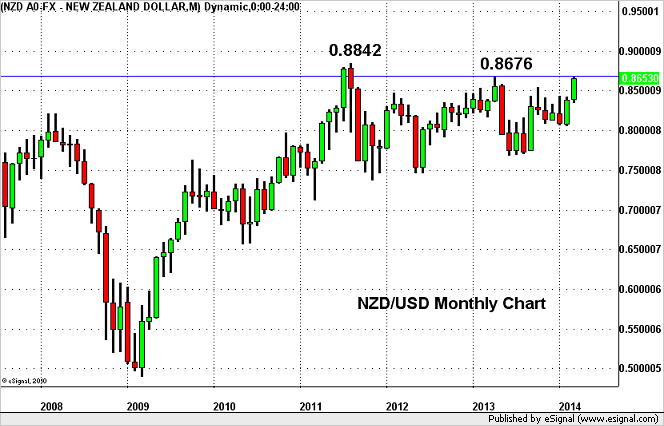In the meantime, the best performing currency today is the New Zealand dollar, which rose to its strongest level against the greenback since August 2011. Last night's better than expected trade numbers kept the currency bid but the main catalyst for the move were the comments from RBNZ Deputy Governor Spencer. Like the Australian dollar, currencies are responding more to comments policymakers than economic data. Spencer said the lack of loan limits "may have prompted monetary policy tightening to have started somewhat earlier." He believes the central bank is happy with the current policy framework and while NZD/USD appreciated more than 7% over the past 2 months, Spencer did not express any renewed concerns about the currency. Instead he said exporters have adjusted to the high exchange rate, which suggests that they don't plan to slow tightening or intervene in the currency as a result of NZD strength.
If NZD/USD ends the day above its April 2013 high of 0.8676, there is no major resistance for the pair until its 2011 high of 0.8842.

Recommended Content
Editors’ Picks

GBP/USD rises above 1.3300 after UK Retail Sales data
GBP/USD trades with a positive bias for the third straight day on Friday and hovers above the 1.3300 mark in the European morning on Friday. The data from the UK showed that Retail Sales rose at a stronger pace than expected in August, supporting Pound Sterling.

USD/JPY recovers to 143.00 area during BoJ Governor Ueda's presser
USD/JPY stages a recovery toward 143.00 in the European morning following the initial pullback seen after the BoJ's decision to maintain status quo. In the post-meeting press conference, Governor Ueda reiterated that they will adjust the degree of easing if needed.

Gold consolidates weekly gains, with sight on $2,600 and beyond
Gold price is looking to build on the previous day’s rebound early Friday, consolidating weekly gains amid the overnight weakness in the US Dollar alongside the US Treasury bond yields. Traders now await the speeches from US Federal Reserve monetary policymakers for fresh hints on the central bank’s path forward on interest rates.

Shiba Inu is poised for a rally as price action and on-chain metrics signal bullish momentum
Shiba Inu remains strong on Friday after breaking above a symmetrical triangle pattern on Thursday. This breakout signals bullish momentum, further bolstered by a rise in daily new transactions that suggests a potential rally in the coming days.

Bank of Japan set to keep rates on hold after July’s hike shocked markets
The Bank of Japan is expected to keep its short-term interest rate target between 0.15% and 0.25% on Friday, following the conclusion of its two-day monetary policy review. The decision is set to be announced during the early Asian session.

Moneta Markets review 2024: All you need to know
VERIFIED In this review, the FXStreet team provides an independent and thorough analysis based on direct testing and real experiences with Moneta Markets – an excellent broker for novice to intermediate forex traders who want to broaden their knowledge base.